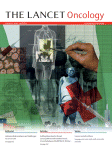Lancet Oncol:沙利度胺维持治疗无益于延长恶性胸膜间皮瘤患者生存期
2013-04-26 Lancet Oncol 丁香园
在恶性胸膜间皮瘤患者中,即使采用标准化疗方案,这些患者的生存期也不长。恶性胸膜间皮瘤的生长高度依赖于血管数量和血清血管生长因子浓度。而沙利度胺具有抗血管生成活性,因此,来自阿姆斯特丹荷兰肿瘤中心的Wieneke A Buikhuisen等假设在恶性胸膜间皮瘤患者维持期的治疗中采用沙利度胺进行治疗可以改善他们的临床预后,为了验证上述假设,他们设计了相关研究并将研
在恶性胸膜间皮瘤患者中,即使采用标准化疗方案,这些患者的生存期也不长。恶性胸膜间皮瘤的生长高度依赖于血管数量和血清血管生长因子浓度。而沙利度胺具有抗血管生成活性,因此,来自阿姆斯特丹荷兰肿瘤中心的Wieneke A Buikhuisen等假设在恶性胸膜间皮瘤患者维持期的治疗中采用沙利度胺进行治疗可以改善他们的临床预后,为了验证上述假设,他们设计了相关研究并将研究结果发表在Lancet Oncol 4月最新的在线期刊上。
本研究为开放式标签、多中心、3期随机对照临床研究,纳入受试者的标准为:既往确诊为恶性胸膜间皮瘤或腹膜间皮瘤、至少接受过4个疗程的一线化疗,治疗方案里包含培美曲塞,可包含或不含顺铂或卡铂,并且经上述方案治疗后患者病情未出现进一步进展。符合上述纳入标准的受试者被按照1:1的比例随机分为2组,并根据受试者既往所接受的一线化疗方案、组织学亚型和所接受治疗的医院对其进行分层。这些受试者或接受每日200mg沙利度胺治疗(包括2周时间每日服用100mg)联合积极支持治疗,或仅接受积极支持治疗直至病情出现进展。受试者必须在一线化疗结束后10周内开始沙利度胺治疗。沙利度胺的治疗期限最长为1年,或直至出现受试者所不能耐受的毒性反应。本研究的主要终点是至疾病进展所经过的时间。研究者采用意向治疗分析法对研究结果进行分析。本研究已经进行临床注册,注册号为ISRCTN13632914。
在2004年5月11日至2009年12月23日期间,研究者共纳入了222名受试者,两组各纳入了111名受试者,在积极支持治疗组中有一名受试者之后退出了研究,他的相关数据排除在最后的分析之外。在进行最后分析时,对这些受试者的中位随访时间为33.1月(IQR 22.3-66.8),由临床医生所报道的出现疾病进展的受试者人数在沙利度胺组为104人,在积极支持治疗组为107人,死亡的患者数在沙利度胺组为92人,在积极支持治疗组为93人。至病情出现进展的中位时间在沙利度胺组为3.6月(95%可信区间3.2-4.1),在积极支持治疗组为3.5月(95%可信区间为2.3-4.8),两组差异不具有显著统计学意义。在沙利度胺组中,研究者观察到43人(39%)发生3级或4级副反应事件,而在积极支持治疗组为31人(28%)。在沙利度胺组有2人(2%)发生感觉神经事件,而在积极支持治疗组则未发生,沙利度胺组有2人(2%)发生心脏事件,在积极支持治疗组为3人(3%);至于血栓栓塞事件在沙利度胺组有3人(3%),在积极支持治疗组则未发生。
本研究结果提示,在一线化疗后应用沙利度胺进行维持治疗并不能延长恶性间皮瘤患者至疾病进展时间。因此,我们需要应用不同的治疗策略来改善恶性间皮瘤患者的预后。
与胸膜间皮瘤相关的拓展阅读:

Thalidomide versus active supportive care for maintenance in patients with malignant mesothelioma after first-line chemotherapy (NVALT 5): an open-label, multicentre, randomised phase 3 study
Background
Standard chemotherapy does not lead to long-term survival in patients with malignant pleural mesothelioma. Malignant pleural mesothelioma is strongly dependent on vasculature with high vessel counts and high concentrations of serum vascular growth factors. Thalidomide has shown antiangiogenic activity, and we hypothesised that its use in the maintenance setting could improve outcomes.
Methods
In this open-label, multicentre, randomised phase 3 study, eligible patients had proven malignant pleural or peritoneal mesothelioma and had received a minimum of four cycles of first-line treatment containing at least pemetrexed, with or without cisplatin or carboplatin, and had not progressed on this treatment. Patients were randomly assigned (in a 1:1 ratio, stratified by previous first-line chemotherapy, histological subtype, and recruiting hospital) to receive thalidomide 200 mg per day (including a 2 week run in of 100 mg per day) plus active supportive care or active supportive care alone until disease progression. Patients were required to be registered and to start treatment with thalidomide within 10 weeks after the end of the first-line chemotherapy. Thalidomide was given for a maximum of 1 year or until unacceptable toxicity. The primary endpoint was time to progression. The primary analyses were by intention to treat. The study is registered, ISRCTN13632914.
Findings
Between May 11, 2004, and Dec 23, 2009, we randomly assigned 222 patients, 111 in each group (one patient on active supportive care later withdrew consent and was excluded from analyses). At the time of this final analysis, median follow-up was 33·1 months (IQR 22·3—66·8), and physician-reported disease progression had occurred in 104 patients in the thalidomide group and 107 in the active supportive care group; 92 patients in the thalidomide group and 93 in the active supportive care group had died. Median time to progression in the thalidomide group was 3·6 months (95% CI 3·2—4·1) compared with 3·5 months (2·3—4·8) in the active supportive care group (hazard ratio 0·95, 95% CI 0·73—1·20, p=0·72). 43 (39%) grade 3 or 4 adverse events were reported in the thalidomide group and 31 (28%) in the active supportive care group; neurosensory events were reported by two (2%) patients on thalidomide and none on active supportive care, cardiac events by two (2%) patients on thalidomide and three (3%) on active supportive care, and thromboembolic events by three (3%) patients on thalidomide and none on active supportive care.
Interpretation
No benefit was noted in time to progression with the addition of thalidomide maintenance to first-line chemotherapy. Different treatment strategies are needed to improve outcomes in patients with malignant mesothelioma.
Funding
Dutch Cancer Society (KWF), Eli Lilly, NSW Dust Disease Compensation Board, University of Sydney, and Cancer Australia.
本网站所有内容来源注明为“梅斯医学”或“MedSci原创”的文字、图片和音视频资料,版权均属于梅斯医学所有。非经授权,任何媒体、网站或个人不得转载,授权转载时须注明来源为“梅斯医学”。其它来源的文章系转载文章,或“梅斯号”自媒体发布的文章,仅系出于传递更多信息之目的,本站仅负责审核内容合规,其内容不代表本站立场,本站不负责内容的准确性和版权。如果存在侵权、或不希望被转载的媒体或个人可与我们联系,我们将立即进行删除处理。
在此留言








#Oncol#
57
#患者生存#
67
#Lancet#
77
#胸膜#
124
#生存期#
55
#间皮瘤#
115